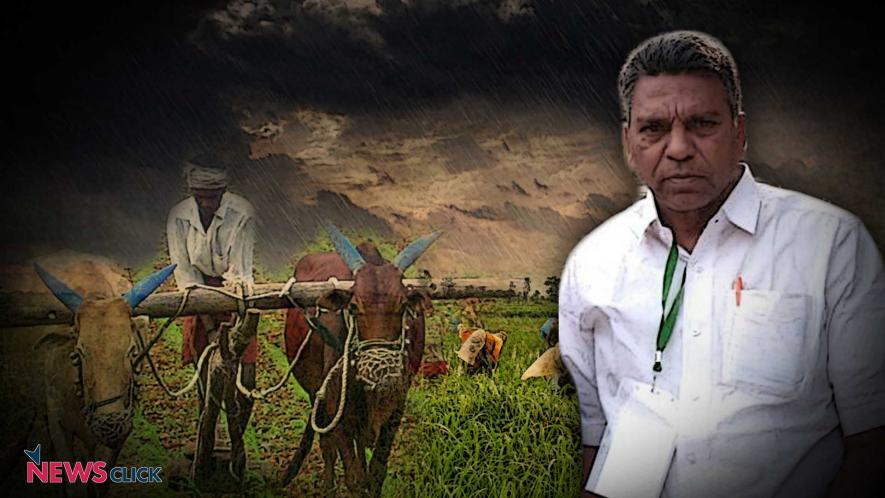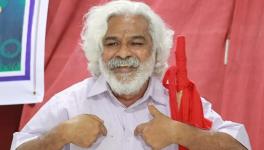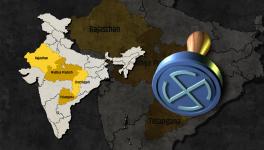Lives of Peasants in India #11

Newsclick Image by Sumit
The year 2017 saw an outpouring of farmers’ protests sweeping the country. To understand why they happened, NewsClick presents a series of profiles of farmers from different parts of India, based on interviews done by students from Delhi, guided by the Society for Social & Economic Research (SSER). See Introduction to series.
Telangana is one of the major chilli producing states of India. In 2016, prices of dry red chillies shot up to Rs. 12,000 per quintal. This was partly on account of high import demand from East Asian and Southeast Asian countries, where hot Guntur red chillies have a considerable market. This attracted many farmers in Telangana and Andhra Pradesh to shift to cultivation of chillies in the hope of getting good returns. A slump in prices of cotton was also a factor for farmers to shift to alternatives like chillies. However, a bumper crop of chillies in India and China this year resulted in a crash in domestic and international (Asian) prices. In 2017, the price of chillies was only between Rs. 3500 and Rs. 5000. This left the chilli growing farmers in extreme distress.
The drastic fall in chilli prices resulted in huge losses for many farmers in the State who were unable to cover even their costs of cultivation. In the absence of any government support, small farmers, who could not afford to store their crop and wait for a better selling price, were the ones to bear the brunt of this price crash. Udumula Balreddy, from northern Telangana, is one such chilly farmer.
Udumula Balreddy (63 years old) lives with his wife, Udumula Mariyamma (60 years), in Cherial village of Siddipet district, Telangana. He has two daughters who are both married. Siddipet is a newly formed district, carved out from former Medak district along with some parts of Karimnagar and Warangal districts. As per the 2011 Census, Cherial is a relatively large village, spreading to an area of about 4526 hectares and inhabited by 4199 households.
Udumula Balreddy owns about 12 acres of land, on which he cultivates red chillies, maize and cotton every year. Agriculture is the main source of livelihood for the household.
Last year, Udumula grew cotton on 4.5 acres of land, maize on 5 acres and red chillies on about 2.5 acres of land. Cotton was planted in July, and picked four times between November and March. Maize was sown in June and harvested in October. Chillies were planted in July, and harvested between February and April. All the three crops were produced for sale; the household did not grow any crop for its own consumption. They harvested about 30 quintals of red chillies, 40 quintals of cotton, and 90 quintals of maize. Cotton was sold directly to a mill situated about 10 kilometres away from the village. At different points of time between November and March, his produce was sold for prices ranging from Rs. 4200-5000 per quintal. Maize was sold to poultry farms in the village itself at Rs. 1310 per quintal. Red chillies were sold to commission agents in Warangal at a rate of Rs. 3500-4500 per quintal.
Udumula gave us a detailed account of costs he had incurred in cultivation of red chillies. Since chillies are highly susceptible to fungal diseases, he had to spend about Rs. 35,000 per acre on spraying fungicides and other plant protection chemicals. For 2.5 acres of chilly, he spent about Rs. 1.76 lakhs on purchased inputs, hired labour and other paid out costs. On account of very low chilli prices in the market, Udumula did not even recover the expenses he incurred in cultivation of the crop. From chilli crop alone he incurred a loss of about Rs. 56,000 over paid out expenditure, and of about Rs. 86,000 once we account for their family labour and rental value of owned capital. It is noteworthy that, if Udumula had received the same prices that chilli farmers got last year, his crop would have given him a return of over Rs. 1.5 lakh after accounting for all costs.
Although he recovered his paid out expenditure on maize and cotton crop this year, even these crops were loss making if we account for the value of his own labour and capital.
Last year, Udumula took a crop loan of Rs. 1 lakh from a bank. With losses incurred in chilly farming, he has been unable to repay even the interest on the loan. Udumula remarked that in absence of any support from the government, it is very difficult to survive in agriculture. Agriculture needs large investment and, with wild fluctuations in market prices, this investment is very risky. With greater trade integration, little subsidies left on agricultural inputs, unremunerative prices and heavy interest burden on loans, the government has left farmers high and dry.
Vaishali Bansal is a Research Scholar at the Jawaharlal Nehru University, New Delhi
Part 1 of the series can be read here.
Part 2 of the series can be read here.
Part 3 of the series can be read here
Part 4 of the series can be read here
Part 5 of the series can be read here
Part 6 of the series can be read here
Part 7 of the series can be read here
Part 8 of the series can be read here
Part 9 of the series can be read here
Part 10 of the series can be read here
Disclaimer: The views expressed here are the author's personal views, and do not necessarily represent the views of Newsclick.
Get the latest reports & analysis with people's perspective on Protests, movements & deep analytical videos, discussions of the current affairs in your Telegram app. Subscribe to NewsClick's Telegram channel & get Real-Time updates on stories, as they get published on our website.
























